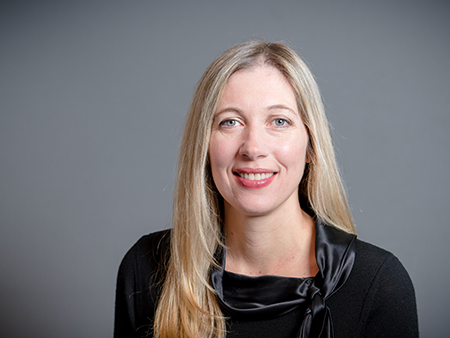Media contact: Bob Shepard
 Overcoming perceived barriers such as work/life balance in the field is a key part of recruiting more women into orthopaedic surgery.Orthopaedic surgery is a medical field composed mostly of men. The American Academy of Orthopaedic Surgeons conducts a census of the profession every two years. In every survey since 2012, at least 90 percent of the orthopaedic workforce has been male.
Overcoming perceived barriers such as work/life balance in the field is a key part of recruiting more women into orthopaedic surgery.Orthopaedic surgery is a medical field composed mostly of men. The American Academy of Orthopaedic Surgeons conducts a census of the profession every two years. In every survey since 2012, at least 90 percent of the orthopaedic workforce has been male.
The number of female orthopaedic surgeons has risen in the last several years, but numbers are still remarkably low. In 2018, only 5.8 percent of the workforce was female.
Sara Gould, M.D., an associate professor in the Department of Orthopaedic Surgery in the Heersink School of Medicine at the University of Alabama at Birmingham, is seeking to boost the number of female orthopaedic surgeons in the United States.
In 2019, the department partnered with the Perry Initiative to host a Perry Outreach Program at UAB, led by Gould. The program is a one-day career exploration for young women in high school who are interested in careers in orthopaedic surgery, engineering or both.
Gould says a total of 36 women — 18 high school students and 18 medical school students — attended the Perry Initiative events and responded to the pre-event and post-event surveys. Gould was able to glean key information from the survey data.
 Sara Gould, M.D., UAB Department of Orthopaedic Surgery.Gould shares that, prior to the Perry Initiative, 31 percent of the total attendees reported knowing a female orthopaedist. The Perry Initiative improved perceptions of both high school and medical students regarding the ability of women to have a work/life balance, family life, and children during orthopaedic residency.
Sara Gould, M.D., UAB Department of Orthopaedic Surgery.Gould shares that, prior to the Perry Initiative, 31 percent of the total attendees reported knowing a female orthopaedist. The Perry Initiative improved perceptions of both high school and medical students regarding the ability of women to have a work/life balance, family life, and children during orthopaedic residency.
Gould ultimately concluded that medical student participation in the events led to a decreased belief in barriers regarding schedule, family life, perceptions of an orthopaedic surgeon, and perceptions of peers within a health care setting.
“It is key to show young women that they can be a part of this field, that there is a seat ready for them here at the table, especially while they are in high school, college or medical school,” Gould said. “These are formative years as students begin to select their ultimate career path, and we want more women to see that orthopaedic surgery is a wonderful choice.”
Gould and Megan Coffin, a medical student who contributed to the research, presented at the American Academy of Orthopaedic Surgeons annual meeting, which followed all COVID-19 protocols, in San Diego, California. To read the entire research report and its methods, click here.